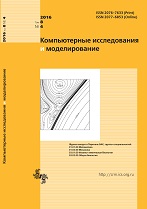|
This article is cited in 7 scientific papers (total in 7 papers)
SOLVING INDUSTRIAL PROBLEMS IN FLOWVISION SOFTWARE
Optimization of a hull form for decrease ship resistance to movement
A. V. Pechenyuk
Digital Marine Technology,
of. 1, 4 Arcadievskiy lane, Odessa, 65062, Ukraine
Abstract:
Optimization of hull lines for the minimum resistance to movement is a problem of current interest in ship hydrodynamics. In practice, lines design is still to some extent an art. The usual approaches to decrease the ship resistance are based on the model experiment and/or CFD simulation, following the trial and error method. The paper presents a new method of in-detail hull form design based on the wave-based optimization approach. The method provides systematic variation of the hull geometrical form, which corresponds to alteration of longitudinal distribution of the hull volume, while its vertical volume distribution is fixed or highly controlled. It's well known from the theoretical studies that the vertical distribution can't be optimized by condition of minimum wave resistance, thus it can be neglected for the optimization procedures. The method efficiency was investigated by application to the foreship of KCS, the well-known test object from the workshop Gothenburg-2000. The variations of the longitudinal distribution of the volume were set on the sectional area curve as finite volume increments and then transferred to the lines plan with the help of special frame transformation methods. The CFD towing simulations were carried out for the initial hull form and the six modified variants. According to the simulation results, examined modifications caused the resistance increments in the range 1.3-6.5 %. Optimization process was underpinned with the respective data analysis based on the new hypothesis, according to which, the resistance increments caused by separate longitudinal segments of hull form meet the principle of superposition. The achieved results, which are presented as the optimum distribution of volume present in the optimized designed hull form, which shows the interesting characteristics that its resistance has decrease by 8.9 % in respect to initial KCS hull form. Visualization of the wave patterns showed an attenuation of the transversal wave components, and the intensification of the diverging wave components.
Keywords:
hull flow simulation, hull form optimization, numerical towing test.
Received: 01.11.2016
Revised: 21.12.2016
Accepted: 30.12.2016
Citation:
A. V. Pechenyuk, “Optimization of a hull form for decrease ship resistance to movement”, Computer Research and Modeling, 9:1 (2017), 57–65
Linking options:
https://www.mathnet.ru/eng/crm46 https://www.mathnet.ru/eng/crm/v9/i1/p57
|

| Statistics & downloads: |
| Abstract page: | 280 | | Full-text PDF : | 142 | | References: | 26 |
|




 Contact us:
Contact us: Terms of Use
Terms of Use
 Registration to the website
Registration to the website Logotypes
Logotypes








 Citation in format
Citation in format 
